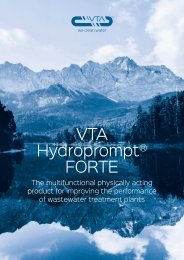VTA Nanocarbon Folder EN
The revolution in wastewater treatment. Liquid intelligence for the adsorptive removal of micropollutants. THE EVOLUTION IN BIO-PHYSICS - Find out more at: www.vta.cc
The revolution in wastewater treatment.
Liquid intelligence for the adsorptive removal of micropollutants.
THE EVOLUTION IN BIO-PHYSICS - Find out more at: www.vta.cc
You also want an ePaper? Increase the reach of your titles
YUMPU automatically turns print PDFs into web optimized ePapers that Google loves.
EVOLUTIONIZING BIO-PHYSICS<br />
REVOLUTIONIZING WASTEWATER TREATM<strong>EN</strong>T<br />
<strong>VTA</strong> <strong>Nanocarbon</strong> ® Video
Cutting-edge fluid intelligence technology<br />
engineered for the adsorptive elimination of<br />
micropollutants.<br />
Introducing the latest advancement in<br />
the <strong>VTA</strong> Liquid Engineering series:<br />
<strong>VTA</strong> <strong>Nanocarbon</strong> ® . This sophisticated<br />
suspension boasts biophysical adsorption<br />
properties at the nanoscale, comprising<br />
functionalized carbon nanoparticles meticulously<br />
combined with specific cationization,<br />
bio activators, and essential bulk elements.<br />
In today’s world, anthropogenic trace<br />
substances or micropollutants are ubiquitous,<br />
ranging from synthetic compounds like<br />
active pharmaceutical ingredients, cosmetics,<br />
pesticides, to industrial chemicals. Even at<br />
low concentrations, these substances pose<br />
human and ecotoxicological risks. Originating<br />
from various sources such as households<br />
and industries, they find their way into<br />
wastewater treatment plants and eventually<br />
permeate the water cycle. Current wastewater<br />
treatment technologies struggle to effectively<br />
retain or degrade this diverse array<br />
of trace substances, leading to pollution in<br />
rivers, lakes, groundwater, and drinking water.<br />
Additionally, conventional wastewater<br />
treatment processes currently lack adequate<br />
measures to effectively address the growing<br />
menace of microplastics, particularly the<br />
minuscule plastic particles that pose significant<br />
health risks.<br />
Thanks to the unique configuration of<br />
<strong>VTA</strong> <strong>Nanocarbon</strong> ® , which maximizes its<br />
active surface area, even small doses within<br />
the existing purification system can efficiently<br />
remove anthropogenic trace substances,<br />
microplastic particles, and AOX in a lowenergy<br />
manner. Administered directly into<br />
the activated sludge of the aeration tank,<br />
it ensures thorough mixing and sufficient<br />
contact time for optimal performance.<br />
Through the application of <strong>VTA</strong> Liquid<br />
Engineering, this cutting-edge process<br />
effectively mitigates fouling and scaling<br />
in biological systems, thus maintaining<br />
operational efficiency over time.
The recorded values reflect the average cleaning effectiveness across different types of<br />
wastewater treatment plants for various anthropogenic trace substances over a one-year period.<br />
100<br />
80<br />
Reduction in %<br />
60<br />
40<br />
20<br />
0<br />
Venlafaxin<br />
(Antidepressant)<br />
Lidocaine<br />
(Local anesthetic)<br />
Carbamazepine<br />
(Antiepileptic)<br />
Metoprolol<br />
(Beta blocker)<br />
Diclofenac<br />
(Painkiller)<br />
Naproxen<br />
(Painkiller)<br />
The EU Urban Waste Water<br />
Directive mandates an average<br />
removal rate of 80%.<br />
100<br />
80<br />
93%<br />
Reduction in %<br />
60<br />
40<br />
20<br />
0<br />
<strong>VTA</strong> <strong>Nanocarbon</strong> ® removes<br />
up to 93% of significant<br />
trace substances!
Microplastic particle<br />
reduction in %<br />
100<br />
80<br />
60<br />
40<br />
20<br />
Reduction of microplastic<br />
particles through<br />
<strong>VTA</strong> <strong>Nanocarbon</strong> ®<br />
Extensive testing has revealed that<br />
<strong>VTA</strong> <strong>Nanocarbon</strong> ® effectively<br />
eliminates up to 99% of microplastic<br />
particles, especially those in the lower<br />
micrometer range. The microplastic<br />
analysis is carried out using a high-tech<br />
laser-directed infrared spectrometer.<br />
Illustration of the reduction performance<br />
of <strong>VTA</strong> <strong>Nanocarbon</strong> ® in relation to<br />
microplastic particles.<br />
AOX reduction in %<br />
100<br />
80<br />
60<br />
40<br />
20<br />
0<br />
Reduction of AOX levels<br />
through <strong>VTA</strong> <strong>Nanocarbon</strong> ®<br />
By employing <strong>VTA</strong> <strong>Nanocarbon</strong> ® ,<br />
non-naturally degradable pollutants<br />
like AOX can be effectively removed<br />
from wastewater by up to 93%.<br />
Illustration demonstrating the<br />
reduction of AOX achieved<br />
through <strong>VTA</strong> <strong>Nanocarbon</strong> ® .
A<br />
B<br />
An illustration showing the floc morphology prior to (A) and during (B) the application<br />
of <strong>VTA</strong> <strong>Nanocarbon</strong> ® , both magnified at 100x.<br />
<strong>VTA</strong> <strong>Nanocarbon</strong> ®<br />
Sedimentation curve for activated sludge<br />
Common coagulants<br />
<strong>VTA</strong> <strong>Nanocarbon</strong> ®<br />
sludge blanket<br />
time [min]<br />
Experience enhanced sludge properties with <strong>VTA</strong> <strong>Nanocarbon</strong> ® . Our solution promotes<br />
an optimal and dense floc structure, maximizing solids’ settling speed for unrivaled<br />
operational reliability, even under heavy hydraulic loads. Furthermore, it boosts biological<br />
activity, ultimately improving the purification performance of your wastewater treatment<br />
plant.<br />
The compact floc configuration permits efficient oxygen dispersion, maximizing oxygen<br />
utilization. This facilitates a possible decrease in aeration energy usage of up to 30%<br />
during the activated sludge phase, playing a pivotal role in advancing energy efficiency<br />
and environmental sustainability in wastewater management.
www.vta.cc<br />
No hazardous goods<br />
Optimizing Your Carbon Footprint<br />
<strong>VTA</strong> Austria GmbH<br />
<strong>VTA</strong> Technologie GmbH<br />
Umweltpark 1 - 3<br />
4681 Rottenbach<br />
Phone: +43 7732 41 33<br />
E-mail: institut@vta.cc<br />
<strong>VTA</strong> Deutschland GmbH<br />
Henneberger Straße 1<br />
94036 Passau<br />
Phone: +49 851 988 98-0<br />
E-mail: institut@vta.cc<br />
<strong>VTA</strong> Schweiz GmbH<br />
Kalchbühlstrasse 40<br />
7000 Chur<br />
Phone: +41 81 252 27-09<br />
E-mail: institut@vta.cc<br />
<strong>VTA</strong> Česká republika spol. s r.o.<br />
Lannova tř. 63/41<br />
370 01 České Budějovice 1<br />
Phone: +420 385 514 747<br />
E-mail: institut@vta.cc


















